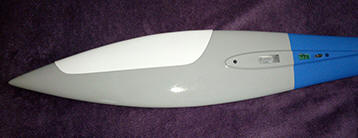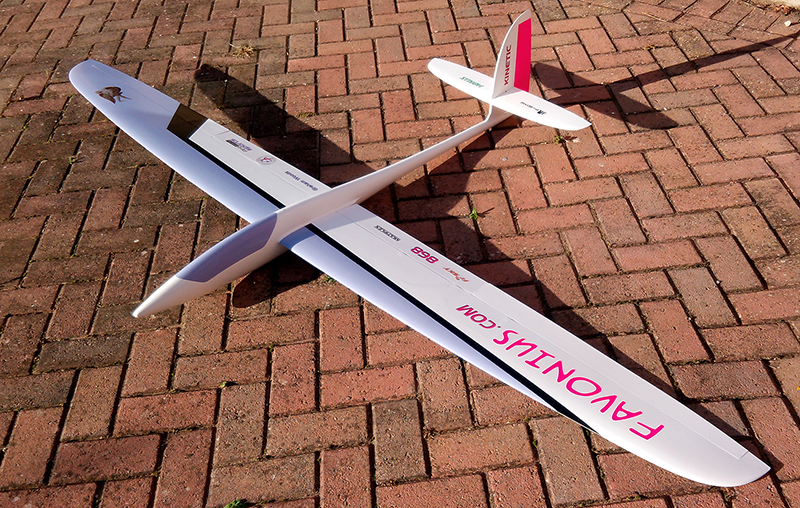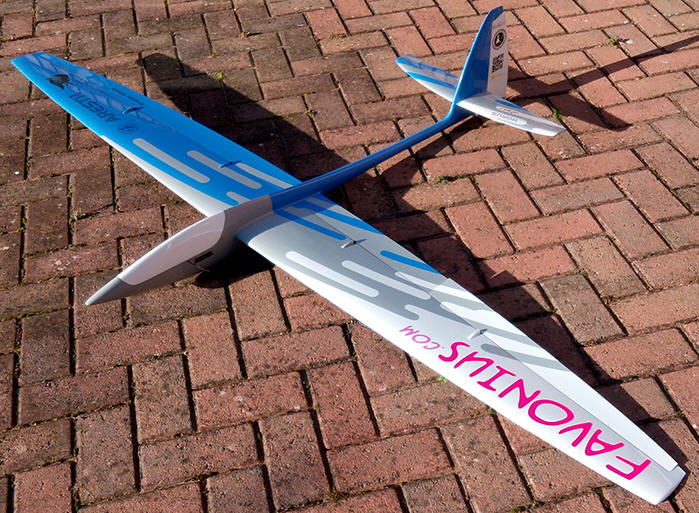|
RAPTOR - ARESTI - FLY - OFF Both brother David (right, launched by Steve Burns) and I now have examples of both of the best commercially available aerobatic slope gliders there are today, the Aresti 2M and the Raptor (or in my case its Kinetic iteration). Both models are extremely aerobatic but each have their shortcomings (and this is probably not the best word, differences, perhaps). One is larger than the other, the Raptor comes in at near enough 2.4 metres while the Aresti is just 2 metres span. One of the bigger differences is the wing loading and here the Raptor wins with a lighter loading ex-ballast than the Aresti. This gives the Raptor better light air performance coming in at 15-16oz/sq.ft. One can add the supplied brass wing ballast to the Raptor and this does enhance its performance through some manoeuvres since it has more Kinetic (get it) energy. The Aresti will carry both wing and fuselage ballast. The Ailerons The roll rate on the Aresti is faster than the Raptor partly due to its smaller wingspan but I reckon the roll is more or less axial on both models with not much to choose between them. Both David and I cut back the top skins of our Arestis and Raptors by 1-2 mm to get more 'up-aileron' movement. We can also invoke full-span ailerons with a switch as well as regular ailerons to give us that bit extra in the roll.
The first Arestis did in fact have a smaller rudder but David persuaded Jim Hammond of Aeroic in Taiwan, the designer, that it needed to be larger and it was made so. The rudder on the Aresti 2M, then, seems to be more effective than that of the Raptor given that both have 45º+ movement. Sadly, both models have a 'carbon rod-in-snake' pushrod and a rudder that is hinged on one side in the mould with Kevlar and/or Peel Ply. Such an arrangement is unsatisfactory as, over time, the continual pushing of the push rod against the fabric hinge weakens it and it can fail. A better system is a regular push-pull closed loop wire from nylon covered fishing trace wire, IMHO. |
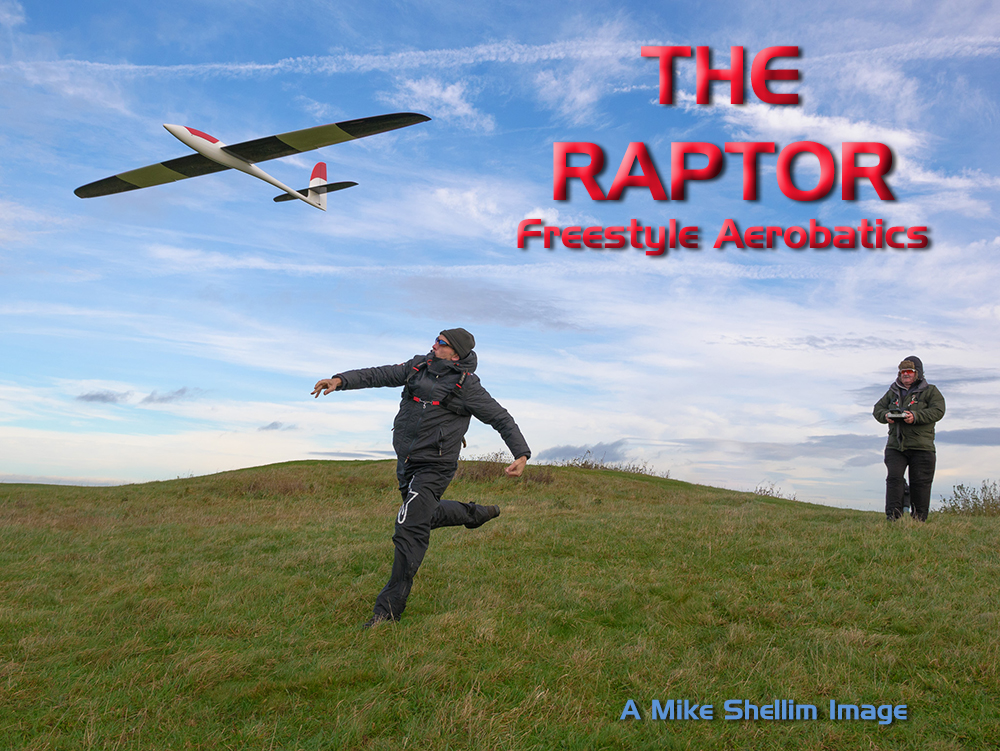 |
|||||||||||||||||||
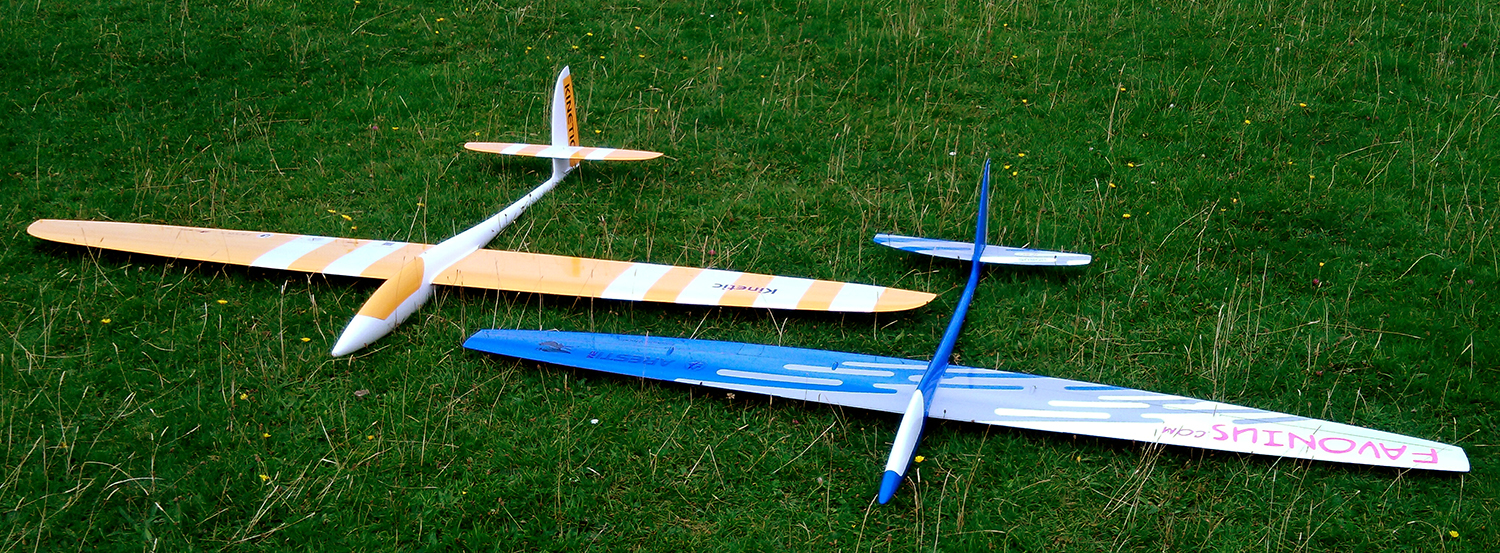 |
The Tailplanes
These are problematic in both aircraft. The Aresti has a fixed tailplane and moving elevator while the Raptor has an all moving tailplane. It is not entirely clear how to go about this in the Aresti as it can be either a 'carbon rod-in-snake' pushrod or a fin mounted servo with a direct drive to the elevator as there is a hatch cut into the fin. I opted for the servo in the fin method but this has problems of its own. Ideally, one needs a longer arm to get maximum resolution but the fin is narrow, the elevator movement required is small, 5-7mm, so a clevis as close in to the servo spline in necessary to try and get the best resolution. This involves drilling a new hole in the servo arm for the brass fixing. This servo must be secured well in the Aresti as it is prone to coming loose on a heavy landing but it must also be able to be removed if necessary in the event of a mishap. Five minute epoxy is the best idea but one needs to keep an eye on this fixing as the servo can come lose and may not be noticed under that hatch. This hatch could be replaced by clear plastic of course. My Aresti page:
aresti\aresti.htm |
|||||||||||||||||||
| The Raptor has an all moving tailplane with a
peculiar two part bellcrank system in the fin. Brother's model came
with the bits but no explanation as to how to install this weird
set up in a fuselage with its rudder post in place. In facts some
parts were missing (two ballraces and tube) from the 'kit'. He managed it in
the end after having to cut a hatch in the fin! btw. (My Kinetic has
a simple carbon pushrod.) All moving tailplanes
are notorious for being wobbly with the tail halves rotating on the
their dowels or the tailplane dowel rotating inside the tube in the fin. The Raptor addresses this to some extent by using a pair of
ball races in the fin to support the tailplane on which it rotates. It seems to be quite
slop free in David's model but he did have to do some sanding etc.
to get the carbon tailplane joiner to fit tightly but lose enough to
move in and out of the ball races on assembly. It took him a while
to get this right. Generally, Baudis,
the manufacturer charges an extra €55 per servo installation fee. I believe
the designer of the Raptor, Keith Groombridge, has addressed this
bellcrank situation in production models. If you do not want any
installation problems this firm will install all 6 servos, for a
price!
Not too much to choose here, both fuselages are excellent quality but maybe a tad too strong at the rear. While this strength is a good thing in some respects it does mean more noseweight which, by the way, both models needed to balance. The Raptor fuselage is wider, more scale-like, and has internal bulkheads. The Aresti has a narrow fuselage just wide enough for a single servo. They are both full of carbon which can present a problem with 2.4GHz radio except that both models have 2.4GHz 'friendly' noses and canopies. I shall be switching over to UK modellers' UHF band on 459MHz or 868MHZ (863-870 EU ISM) I think to make sure. I got RSSI warnings at just 150 metres in some attitudes on 2.4GHz and crashed my carbon Aresti 2m. This is the bit that isn't carbon btw, see my image :-) The Wings Both wing sets are symmetrical with a super finish though the Raptor's are only 8% thick against the Aresti's which are 10%. I believe the Raptor has a Thierry Platon section while the Aresti has a Jim Hammond 'double cusp' section (whatever that means). The Aresti has 'traditional' clevis to clevis servo fittings in the wings though the Raptor has its own LDS system by Baudis. The Raptor LDS is a slop free linkage, not so easy to install yourself (I am told by bro) unless you know what you are doing. My Kinetic has hidden RDS. Both models can use butterfly for landing but here there does seem to be a difference here due, perhaps, to the sections themselves. The Aresti seems to have a more abrupt stall and takes longer to recover. Therefore, the Aresti can 'flick' for the unwary in tight manoeuvres and catch one unawares. On landing, putting butterfly in and out to control the approach, the Aresti's inability to recover quickly can be a problem and heavy landings can ensue as the Aresti fails to gain flying speed quickly enough. The Raptor on the other hand is more docile and very, very easy to land having a gentler stall it seems and much easier to land gracefully. |
||||||||||||||||||||
| Aerobatics These two models come into their own on the right slope, they are lost on massive slopes where larger models are needed. Both models improve their performance with added ballast. The Aresti, already with a greater wing loading than the Raptor, will certainly fly very fast with 560g of wing ballast (lead in K&S brass) and maintain its energy in stall turns and, given its smaller size, feel much more twitchy than the Raptor carrying its 550g (rectangular brass supplied) The up-lines in stall turns (half-pipes) are better with the Aresti with the Raptor tending to weathercock into strong winds even with full opposite rudder. The Aresti, with our setups, rolls faster too. Where the Raptor has the edge is in loops and bunts, I feel the Raptor really does snap round that last piece of the outside loop even without 'snap-flap' which we both can switch in and out. I should say the Raptor's aeros are more elegant and deliberate than the Aresti's (I have to be careful of over rolling) and its tendency to flick, and or just suddenly lose kinetic energy with too much, too fast elevator input. The Aresti is the faster model I reckon. The Raptor thermals well and readily responds to lift, its inverted performance always seems to need some 'down elevator' which seems odd considering the symmetrical section and a rearward CG (96-100mm). The Aresti flies very well inverted. Both models are not easy to launch so you may need a friend on the slope in high winds to be sure; however, we both use hangers on our FrSky and Jeti transmitters which allows us to make two-handed launches. I do crash models, even after 40 years on the slope as I said. I recently put my Aresti in the hill after what I thought was a signal problem considering the amount of carbon in my model. It was my own fault though for, 1) failing to heed low RSSI warnings, 2) being over confident, 3) flicking the model. |
|
|||||||||||||||||||
|
The nose was pretty much buried in the side of the hill as you can see but I have put it back together. The tailplane and rudder had no damage whatsoever, nor the fuselage behind the wing dowel, one wing was undamaged while the other 'sprang apart'. I repaired it with slow epoxy resin using a syringe to get the resin in the correct place and re-sprayed the front half of the fuselage. Luckily the wing was not creased nor the tail boom of the model snapped or even weakened. All 6 servos survived as well. I have also changed the colour scheme on my Raptor. So here is a side by side comparison of my two aerobats... |
||||||||||||||||||||
|
I finally finished re-painting my Kinetic and, naturally enough, that added extra weight; about 100g in primer, top coat and lacquer but it looks like I may have to add some extra noseweight as well. Still, I like my new asymmetrical paint job and my latest graphics. Here are my new numbers for it: tailplane 84 (70), left wing 568 (542), right wing 581 (535), Fuse 1089 (1067) dowel 98. Total 2420 plus ~30g extra noseweight makes 2450, a loading of 50.8gdm-2 (16.7oz/sq.ft) My repaired Aresti2M is now back in flying condition as well. Note, the 2.4GHz antennas are now poking out from the Aresti 2M fuselage sides. The images of my un-flown models were taken in November 2017. Prices Take a deep breath... The Aresti 2M, when it is in stock, seems to come in at £565 while the Raptor is priced at €1100 for the single or €1390 for the double carbon. Your own servos can be installed in the Raptor by Baudis for €55 each servo. You have to state which servos you are going to use when you order. The options are KST or MKS generally.
|
||||||||||||||||||||
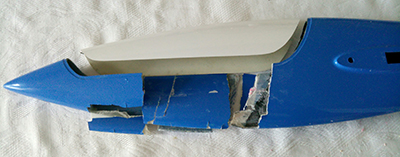 The
Fuselages
The
Fuselages